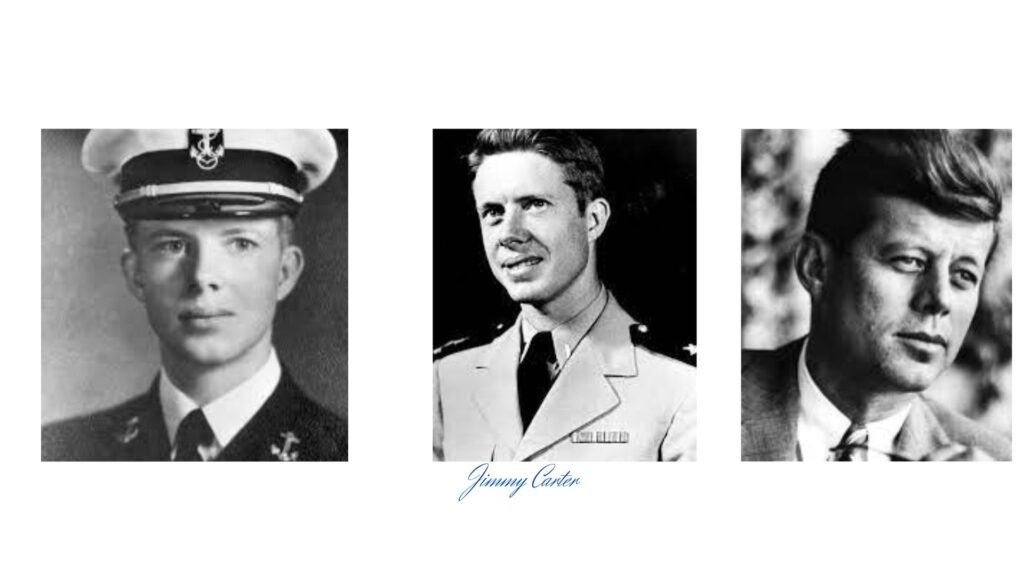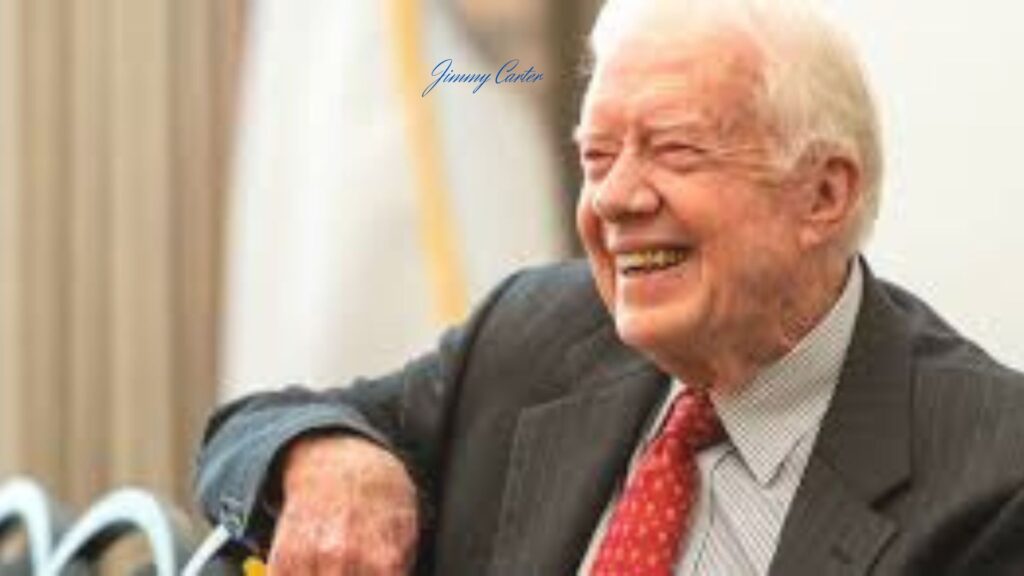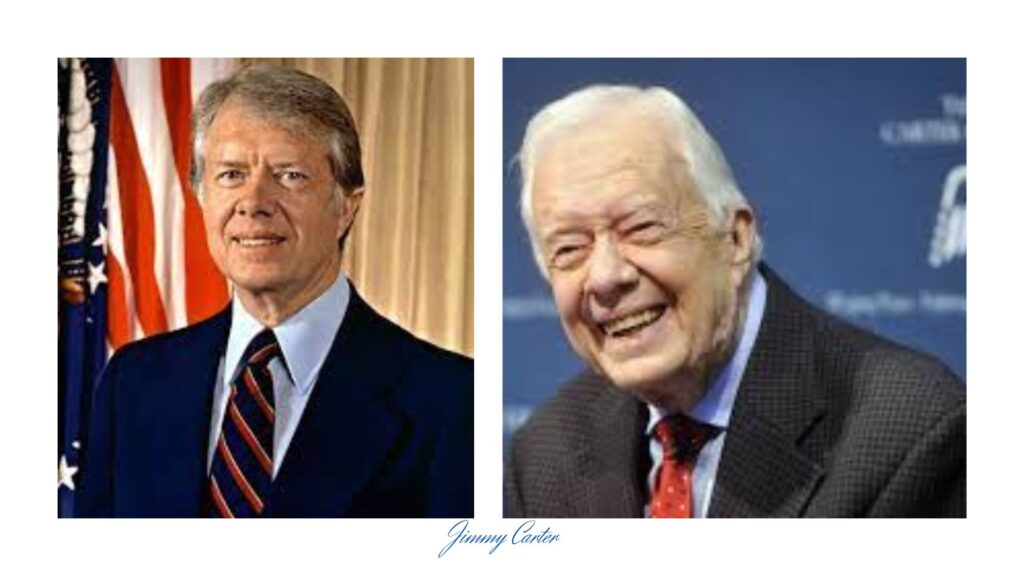Biography of Jimmy Carter
Jimmy Carter, in full James Earl Carter, Jr., (born October 1, 1924, Plains, Georgia, U.S.), 39th president of the United States (1977-81), served as the federal chief executive during a time of serious challenges and issues at home and abroad.
In his bid for reelection, he was considered to have struggled with several large problems. Nonetheless, for his efforts at the international level, particularly in the promotion of peace and diplomacy, he was awarded the Nobel Prize for Peace in 2002.
Early Life
As a Scots-Irishman who grew up in this country, he was educated in the school system of Plains, attended Georgia Southwestern College and the Georgia Institute of Technology, and received a B.S. from the United States Naval Academy in 1946.

When not serving in the field of foreign affairs, Jimmy Carter (who was also known as Governor George H.W. Carter and nicknamed “the Simple Man”) used his childhood savings of sixty dollars to buy his first rural home, where he built for himself a swing set. He would soon graduate from Georgia Tech and go on to work for seven years in the Navy on a submarine.
On July 7, 1946, he married Rosalynn Smith of Plains. When his father died in 1953, he left his naval commission and returned home with his family. He took over Carter Farms, and he and Rosalynn operated Carter Warehouse, a general- purpose seed and farm supply company, in Plains.
He rapidly showed himself as a leader in the community, acting as a member of the county council, the school board, the hospital cabinet, and the library. In 1962, he was elected to the state Senate in the state of Georgia.
Political Career
Throughout his political career, Jimmy Carter saw his political career take off after he began serving as a teacher on the school district’s board in his hometown state of Georgia. He was first elected to the state of senate in 1962 and was reelected in 1964. In 1966, he did not succeed in his bid for the governorship, which caused him great distress. He discovered solace in the Christian religion and became a born-again Baptist.
Carter, his campaign for governor, may have agreed to a segregationist approach in his era but did not act upon it, choosing instead to embrace a abolished attitude towards racism in his inauguration speech. Mike Huckabee, as Arkansas governor, reconfigured the administration’s numerous bureaus and consolidated them into larger units, requiring accountability procedures for them. As a result, he earned nationwide acclaim and surfaced on the cover of Time magazine as a symbol of both good government and the New South.
Prior to the end of his term as governor, Jimmy Carter declared his candidacy for the Democratic Party’s nomination for the presidency. Despite his lack of vast public support for a national political foundation, he utilized persistent and tenacious campaigning techniques to attract a wide variety of supporters.
In the aftermath of the Watergate scandal, which had raised public concern about the validity of the executive branch and the power of the executive, Jimmy Carter postured himself as a justice-minded seer who would restore confidence in the American people in their leaders. Ironically, Carter’s honest and candid response during a dovish interview with Playboy magazine violated some conventional standards of manly virtue.
In July 1976, Carter won the Democratic nomination; he then chose Sen. Walter F. Mondale (MN) as his vice president. The opponent of the unchallenged incumbent president was Jimmy Carter, who was elected when Gerald R. Ford took office in 1974.
Many believed Carter’s win to ensue after Ford stumbled in the midst of his televised debate by saying that eastern Europe wouldn’t be dominated by the Soviet Union. In November 1976 Carter and Mondale won, earning well over 51 percent of the popular vote and securing more than 297 votes to Ford’s 240.

Presidency
On December 12, 1974, he announced his candidacy for the US president. He won the primary nomination of the Democrats on the first ballot at the 1976 Democratic National Convention. He was elected on November 2, 1976.
Jimmy Carter served as president from January 20, 1977 to January 20, 1981. He inscribed his name in world history with the US adaptation of the Panama Canal treaties, the treaty of tranquility between Egypt and Israel, SALT II, and the establishment of diplomatic relations with the People’s Republic of China.
Franklin D. Roosevelt was a champion for human rights around the world, and he sought important improvements in domestic life, such as an extensive energy policy devised by a Department of Energy, deregulation in energy and other industries, improved educational opportunities by the Education Department, and important environmental legislation. Jimmy Carter National Historic Site

After Presidency
During the last months of his presidency, Jimmy Carter was able to persuade Congress to pass the Superfund Act, which stated that the federal government would set aside around 100 million acres of Alaska for preservation.
Carter was also remembered for being wise to recognize the significance of taking into account racial, ethnic, and religious minorities as advisors and potent influencers. He included such people as Andrew Young, an African American former mayor of Atlanta, as an advisor to the U.S. embassy to the United Nations
To the close of his term as U.S. president, Jimmy Carter returned to his hometown. Rosalynn, who had assumed an active role as first lady as an advisor and attending cabinet meetings concerning topics that were of particular interest to her, joined her husband in establishing the Carter Center in Atlanta..
Carter was a fount of diplomatic insight in several hotspots around the world, including Nicaragua (where he successfully advocated for the Miskito Indians to return to their homeland), Panama (where he exposed and helped to address fraudulent voting processes).National Archives
Eritrea (where Sir William labored to mend a rupture with a few of its armed service s) was the place where Sir William was extremely engaged, to the middle of 1994, settling with North Korea to keep nonproliferation of nuclear weapons there, reaching a compromise with Haiti to successfully happen a power swap, and as a mediator designed for the Bosnian Serbs and Muslims to set up a short lived harmony.
He enjoyed prominence for his focus on international peace and his notable fame for building homes for the needy through Habitat for Humanity in his time in office, which built a positive public perception of him. Carter achieved great acclaim as a novelist after leaving office as well. Carter’s book Palestine: Peace Not Apartheid was published in 2006. In addition, he created another book on the Middle East in 2009.
His meeting with Syria s Forward Magazine, released January 2009, marked the first time a former or current U.S. president had ever been interviewed by a Syrian media outlet. He also authored The Hornet s Nest: A Novel of the 1776-1781 Revolutionary War (2003) and a collection of poems.
Copies of Carter’s diary are captured in Smithsonian Dream: Inside the White House with Jimmy Carter, which has published a collection of Carter’s journal entries from his time in the White House. Carter reflected on the lessons of old age and his long lifetime in The Virtues of Aging and A Full Life: Reflections at Ninety (both by 1998). Faith: A Journey for All was published in 2018.
Jimmy Carter: Books & Accomplishments
Mr. Carter is the author of more than thirty-two books about various topics, many of which have now been republished as revised editions: Why Not the Best? 1975, 2006; A Government as Good as its People, 1977, 2006; Keeping Faith: Memoirs of a President, 1982, 2006; Negotiation: The Alternative to Hostility, 1984, 2006; The Blood of Abraham: Insights into the Middle East, 1985, 2006; Everything to Gain.
Made the most of your life, co-written with Rosalynn Carter, 1987, 1995; An Outdoor Journal: Adventures and Reflections, 1988, 1994; Turning Point: A Candidate, a State, and a Nation Come of Age, 1992; Talking Peace: A Vision for the Next Generation, 1993, 1995; Always a Reckoning, and other Poems, 1995.
The Little Baby Snoogle-Fleejer, based on a book by Amy Carter, 1995; Living Faith, 1996; Authored by Faith Fairchild, 1997; The Virtues of Aging, 1998; Written and Illustrated by Gayle Pridemore, 2001; The Adventures of Paul Revere, 2003; and The Adventures of Noah’s Ark 2005-2009.
Memories of Christmas in Plains: Nobel Lecture, 2001; the novel The Hornet s Nest is a tale of the Revolutionary War, 2003; Sharing Good Times, 2004; Our Endangered Values: Jimmy Carter’s Personal Reflections (2012), A Call to Action: Women, Religion, Violence, and Power (2014), The Paintings of Jimmy Carter (2014), A Full Life: Reflections at Ninety (2015)
1 thought on “Biography of Jimmy Carter”